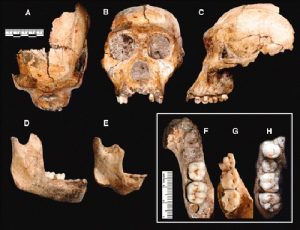W.B.C.S. Examination Notes On – Southern Ape Men – Geology Notes.
In evolution the next primate that followed Ramapithecus was Australopithecus that was first found in South Africa in 1924 by R. Dart, and are now almost unanimously accepted as links between the ape-like and human stages of our ancestry.Continue Reading W.B.C.S. Examination Notes On – Southern Ape Men – Geology Notes.
They lived from at least 3 million to perhaps 1 million years ago. Most of the known remains have been found in southern and east central Africa. There existed at least three species. These three species — of which none represents our ancestors — evolved parallel to them.
Of the three species—a larger with sagittal crests on the skull and less man-like called Australopithecus robustus, not generally considered in direct Homo ancestry, and a smaller without sagittal crests on the skull, a more gracile, A. africanus. A third species, A. boisei, found in East Africa was originally called Zinjanthropus by husband-wife team of Louis Leaky and Mary Leaky in 1959.
Of three species the first apparently died out without issue while the second is our likely ancestor. Dobzhansky et al., (1977) consider two species instead of three.
They presume that there are two species — Australopithecus robustus (= Zinjanthropus boisei) and A africanus but Pough et al., (1996) consider that there are three robust forms — A. robustus (South Africa), A. aethiopicus and A. boisei (East Africa) and were terrestrial, savanna-dwelling vegetarian inhabitants.
The first fossil of a juvenile skull (Taung baby), collected from a cave at Taung in South Africa, was described by Prof. Reymond Dart in 1924. It was named A. africanus (Fig. 10.84B); other fossils under the same genus were collected from East Africa, in the deposits between three and one million years old. The body structure of Australopithecus is a fascinating mixture of human, ape and intermediate traits.
The most significant features of Australopithecus are as follows:
i) Small statured forms averaging up to 4 feet (1.2 m) tall.
ii) The cranial capacity was 450-500 cc, quite larger than that of chimpanzee.
iii) The shape of the pelvis indicates that these creatures walked erect.
iv) The dentition was human-like than ape-like as canines were small like those of man but simian gap was present.
v) Occipital condyles are anterior in position.
vi) Palate reduced but longer than in man.
A. afarensis:
Another a single young female adult skeleton was discovered by Donald Johanson in 1974 in the desert of the Afar Plain and also in Ethiopia. It was named Australopithecus afarensis but is known in the popular literature by the nickname Lucy (named after a Beatles song). It was about 3.2 million years back. Lucy was about 105 cm tall and weighed perhaps 30 kilograms.
The cranial capacity of other individuals of A. afarensis is between 380-450 cubic centimeters, quite resemble to modern chimpanzee and gorilla. Other features like pelvic girdle, molar teeth, and short finger are like humans.
The pelvic girdle and limb bones indicate bipedalism but reflect partial arboreality from her hand bone. Lucy and her relatives were either contemporary with or gave rise to other hominids such as A. africanus (Fig. 10.84B), another Pliocene form, which may be considered as the ancestor of Homo.
Homo habilis [L. homo = man + habilis = handy]:
Again, some fragments were discovered in a deposit about 2-2.5 million years ago at Koobi Fora in Kenya in 1961 by R. E. Leaky. The remains are more modern and may be near about our ancestry and it is included under the genus Homo and named Homo habilis (tool maker). The early men had perfect bipedal locomotion.
Cranial capacity is between 500-750 cubic centimeters and considered to be distinct from Australopithecus. Their height was 150 cm, weight 40-45 kg, protruded jaws and lower jaw lightly built. They had larger front teeth and smaller cheek teeth. They knew to use the chipped stone tool.
Homo Ergaster:
A more advanced skeleton of hominid, called Homo ergaster, appeared between 1.9 and 1.5 million years ago. The shape of the body and limb proportions appears as the modern human beings. Jaws and teeth are also appear like the modern man. So Homo ergaster may be considered as first hominid and safely be placed under the genus Homo.
Please subscribe here to get all future updates on this post/page/category/website


 +919674493673
+919674493673  mailus@wbcsmadeeasy.in
mailus@wbcsmadeeasy.in







































































































